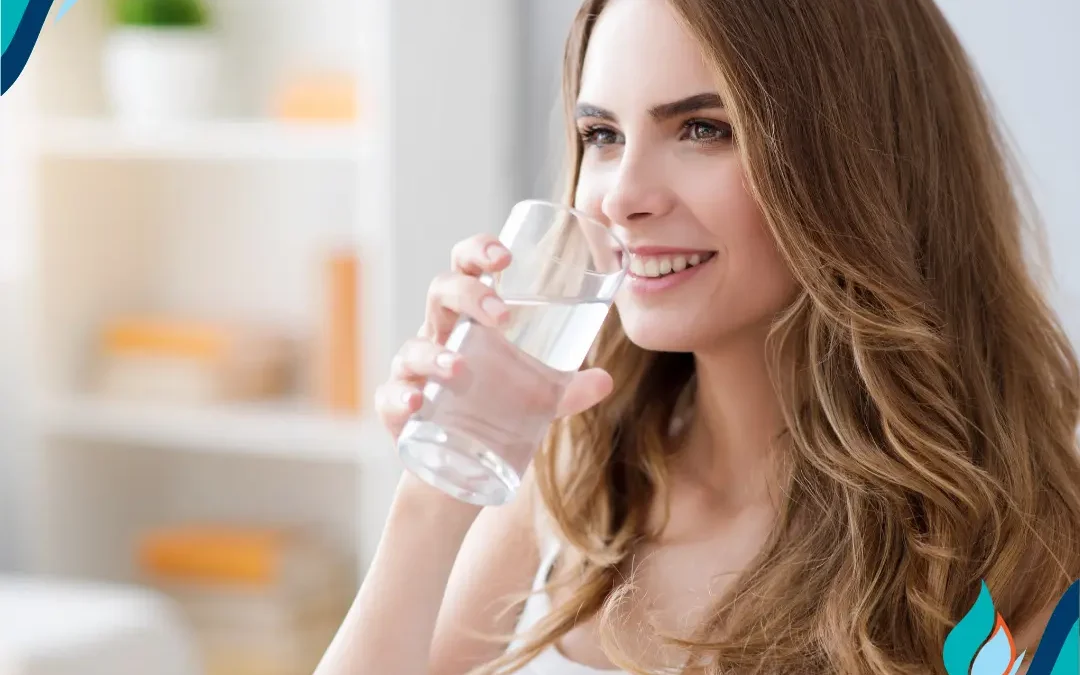Hardness and TDS are both terms we use to talk about water quality, but what’s the difference between the two? The difference between hardness and TDS in water comes down to a matter of taste and safety. The minerals in hard water may result in an unpleasant taste, but high levels of TDS mean the water is not even safe to drink!
What is TDS in water?
TDS refers to total dissolved solids and is used to measure the amount of dissolved impurities in a liquid– in our case, water. These impurities can include minerals, organic matter, and toxic chemicals.
As water makes its way to the water treatment plant, it picks up salt and sediment from the ground. Municipal water treatment filters out the organic matter that hasn’t yet dissolved, in addition to some that are soluble. The resulting water is then delivered to the tap in your home. While the final product is exponentially cleaner and safer drinking water, tap water still contains some minerals and contaminants.
How much TDS is safe for drinking water?
The amount of total dissolved solids in water is measured in parts per million (PPM) and milligrams per liter (mg/L). A higher level of TDS indicates the presence of more minerals, metals, and other solids dissolved in the water.
The World Health Organization (WHO) says that clean drinking water has a TDS level of less than 300 PPM. In the United States, the average level of TDS is 350 PPM for tap water. Any water with a TDS level of 900 or more is considered contaminated and not suitable for drinking water.
What does water hardness mean?
Water hardness, on the other hand, is a little more specific. Hardness refers to the amount of minerals within the water. Hard water is characterized by high levels of dissolved minerals like calcium and magnesium. The presence of these minerals in water makes it less effective for washing, cleaning, and even plumbing.
Water hardness is an important factor to consider, especially when it comes to household appliances and industrial processes. It is typically categorized based on its content of minerals, particularly calcium and magnesium. These categories are defined using three different units: parts per million (ppm), degrees of hardness (dH), and milligrams per liter (mg/l). Let’s break down these classifications for better understanding:
Categories of water hardness
Very Soft Water – This type of water contains minimal mineral content and is often the most gentle on appliances and plumbing.
- PPM: 0 to 60
- dH: 0 to 4
- Mg/l: Not typically measured in this range
Soft Water – Soft water has slightly higher mineral content but is still gentle, reducing soap and detergent usage.
- PPM: 60 to 119
- dH: 4 to 8
- Mg/l: 0 to 19
Medium Hard Water – This is where you might start noticing some mineral deposits, but it is generally manageable for most household uses.
- PPM: 120 to 179
- dH: 8 to 12
- Mg/l: 20 to 50
Hard Water – Hard water can lead to scaling in pipes and appliances. It might require water softening solutions to prevent buildup.
- PPM: 180 to 239
- dH: 12 to 18
- Mg/l: 51 to 120
Very Hard Water – Expect significant scaling and reduced efficiency in heating systems. A water softener is typically recommended.
- PPM: 240 to 500
- dH: 18 to 30
- Mg/l: 121 to 174
Extremely Hard Water – This level of hardness requires intervention to protect appliances and plumbing from severe mineral buildup.
- PPM: Over 500
- dH: Over 30
- Mg/l: Greater than 175
Understanding how water hardness is categorized can help you choose the right water treatment solutions, ensuring appliances run efficiently and avoiding the costs associated with scale buildup.
Is hard water safe to drink?
Water containing high levels of calcium and magnesium may be safe to drink, but the mineral content may affect the taste, smell, and texture. Even though drinking hard water doesn’t pose a risk to your health, it can be harsh on plumbing and other household appliances, and mineral deposits can build up on your skin and hair.
The difference between measuring water quality according to hardness or TDS
While TDS is a great way to measure all dissolved solids, water hardness refers more specifically to the calcium and magnesium content of the water. Hard water is safe to drink. Conversely, high levels of TDS indicate that the water is NOT clean enough to drink.
How to improve your water quality and get the best-tasting drinking water at home
Hard water is generally safe to drink, but the calcium and magnesium ions can result in limescale buildup in your home, soap scum on your clothes, and a bitter taste in your mouth. How can you fix this? The best way to turn hard water into soft water is with a water softener.
With a water softener, the water travels through a filter that traps calcium and magnesium ions. These ions are exchanged for sodium ions and stay in the tank to be flushed out as brine later. Since the sodium ions balance out the charge of the calcium and magnesium ions, the newly softened water flows right into your tap.
Water with high TDS levels can be addressed with the right drinking water system or water filter. A reverse osmosis water filtration system guarantees safe, clean drinking water by removing up to 99% of contaminants. The ultra-thin semi-permeable membrane is the preferred method since it not only filters out insoluble contaminants, but the dissolved impurities as well.
How reverse osmosis works
Reverse osmosis (RO) is a powerful process that effectively separates unwanted materials from your water supply. Here’s how it works:
- Pressure and Membrane: Water is pumped through a specialized membrane at high pressure. This membrane is key to the process, as it allows only water molecules to pass while rejecting contaminants.
- Contaminant Removal: The RO system excels in removing a wide range of impurities like suspended solids (rust and pipe scale), bacteria and algae, and dissolved solids.
Impact of reverse osmosis on plumbing
RO water acts as a superior solvent, which can have implications for plumbing systems, particularly those made from copper. Over time, copper pipes can develop oxide layers that seal pinholes. Introducing RO water might dissolve these oxides, potentially exposing leaks. However, copper pipes used with RO water from the start may enjoy a longer service life due to reduced corrosion rates.
By understanding these details, you can fully appreciate how reverse osmosis stands as a robust solution for purifying water, ensuring your supply remains both clean and safe.
Find a drinking water system that fits your needs with CalSoft Water
Hardness and TDS are both ways to measure impurities in water. But while hardness measures calcium and magnesium content, TDS addresses the safety qualities of the water. A water softener helps address hardness by removing minerals from tap water. A drinking water system that uses reverse osmosis filtration guarantees safe drinking water by reducing the amount of total dissolved solids in the water, which can include both organic and inorganic contaminants.
With the recent water contaminations, it’s about time to find a drinking water system for your Santa Maria home or business. CalSoft Water offers an environmentally friendly Water Softener Exchange Tank service, along with reverse osmosis filtration systems, water softeners, and water conditioners to meet your water needs. Contact us today!

